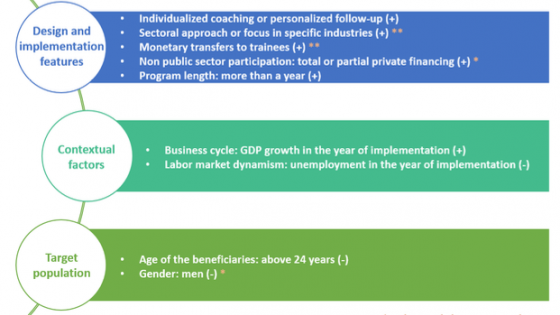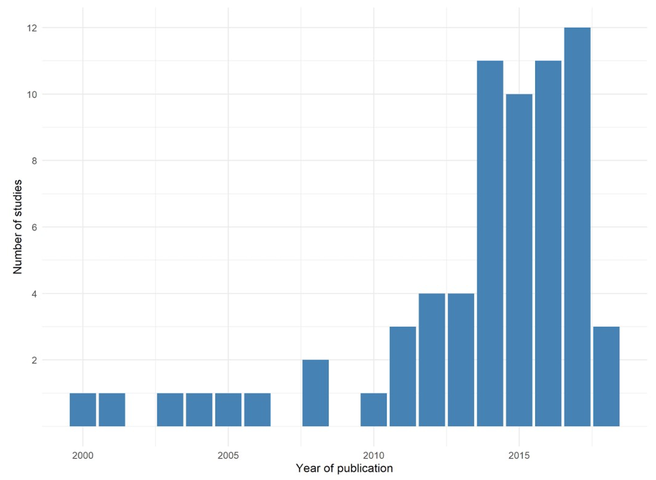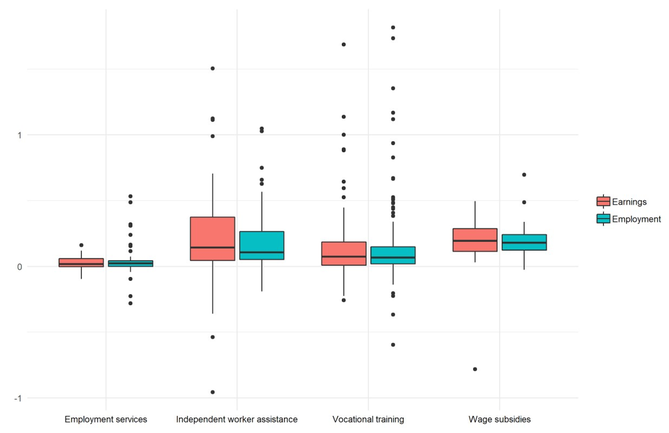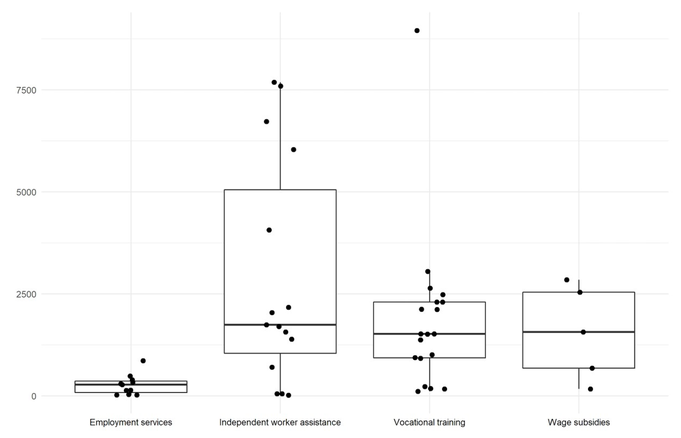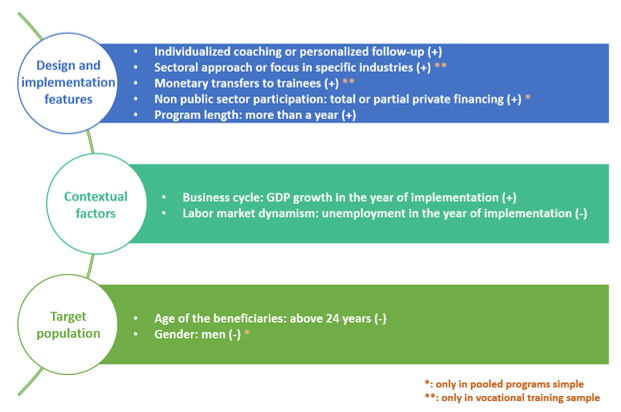Having an effective set of active labour market policies (ALMPs) is essential to meet the challenges that automation, globalisation and demographic change impose on the labour market. Active Labour Market Policies are a general denomination for specific policies that could be broadly grouped into four big policy clusters – vocational training, assistance in the job search process, wage subsidies or public works programmes, and support to micro-entrepreneurs or independent workers. Governments allocate significant fiscal resources to ALMPs (in the past 10 years, such policies have accounted for more than 0.5% of the GDP of OECD countries) to reduce unemployment levels, increase labour income and facilitate the adoption of new technologies that boost productivity. However, evidence is often scarce and mixed as a guide in the design of effective policy solutions.
In a recent paper (Levy Yeyati et al. 2019), we analysed the effectiveness of these policies through a systematic review of more than 100 experimental evaluations that documented the effectiveness of ALMPs implemented worldwide. Specifically, we focus exclusively on programmes evaluated through Randomised Control Trials (RCTs), exploiting the fact that the past five years have witnessed a flurry of RCTs that shed new light on the impact and cost effectiveness of ALMPs (Figure 1).1 This focus on RCTs reduces the number of relevant evaluations, but allows us to focus on estimates with high internal validity and to refine the metrics used to compare results, making the findings from individual evaluations more naturally comparable.2
Figure 1 Distribution of studies included in our sample according to the year of publication
Note: 2018 data point includes only studies published up to June of 2018.
The effectiveness of multidimensional and complex policies such as ALMPs depends on how they are designed, on the quality of their implementation, on the context in which they were developed, and on their target population. For example, a vocational training programme may differ in its cost and duration, in its curricular content, and in whether or not, and how, the private sector participates, and may address a very diverse public, from experienced software programmers in Tokyo or Chicago to disadvantaged youth in the state of Madhya Pradesh. An analysis that ignores these considerations can hardly give specific and conclusive lessons for policymakers.
Following Pritchett et al. (2013), our four policy clusters can be treated as ‘classes’ of policies that could be designed and implemented in very different ways and target diverse demographic groups, with widely varying effectiveness. A review that does not consider this variability could draw conclusions of the type ‘wage subsidies work’ or ‘vocational training does not work’, statements as imprecise as ‘the ingestion of chemical components works’.3 To account for the dimensionality of the problem in an operational way, we propose a design space (a parsimonious version of the space of all of the possible instances of a class of policy, arrived at by specifying all of the choices necessary for a project to be implemented) that characterises: (i) the specific components in which the programmes can be decomposed; (ii) the implementation features and the type of public-private participation; and (iii) the economic context and the target population of the programmes. This allows us to refine the analysis and identify why policies that are similar on paper can differ in their impact and cost-effectiveness, and to isolate the specific effect of a large set of standardised variables that granularly describe the design, implementation, context and target population of our 102 ALMPs. To characterise these dimensions, we analysed all the information available in the academic publications and condensed the description of the criteria used for the identification of each of the variables into unified protocols that articulate the review process.
Comparing the overall impact of the four policy clusters analysed, we find that wage subsidies and independent worker assistance show the greatest median impact on earnings relative to the control group, with improvements of 16.7% and 16.5%, respectively. On the other hand, vocational training programmes have a median impact of 7.7%, while employment services show an almost negligible impact. The median impact on employment exhibits a similar pattern, with wage subsidies being the type of programme which reports the highest impact on this outcome category, while independent worker assistance and vocational training show a median impact of 11% and 6.7%, respectively. Interestingly, employment services interventions have a median impact of 2.6%, consistent with short-lived and inexpensive interventions that do not attempt to help build human capital, but rather to improve the propensity to find employment.
Importantly, there is a substantial variability in reported impacts on earnings and employment outcomes. This is especially true for the type of interventions in which we have more than 10 cases, such as employment services, independent worker support or assistance, and vocational training (Figure 2).
Figure 2 Boxplot of the 652 coefficients according to the estimated effect relative to the control group
Notes: Estimates are grouped by type of programme and outcome category. Boxes represent the 50% central coefficients reported. The horizontal lines show the median value. The vertical lines show the last coefficient that falls into the +/- 1.5*interquartile range limit. Points are observations that lay above or below the +/- 1.5* interquartile range limit.
When the information is available, we add a continuous variable that identifies the average cost per person of the intervention, in 2010 PPP dollars. It is important to stress that only 51 interventions reported this critical variable, and only 22 carried out a rigorous cost-benefit analysis by means of net present value, internal rate of return or payback periods, highlighting an important limitation of the usual practice in the impact evaluation literature.
Although the sample of ALMPs for which we have cost data is limited, we can identify some indicative patterns. Wage subsidies, support to independent workers or micro-entrepreneurs and vocational trainings have comparable median cost per participant, ranging from 1,744 and 1,518 2010 PPP US dollars, with much greater variability in the second group. In turn, employment services are notably less expensive policies, with a median cost per participant of 277 2010 PPP US dollars and limited variability across programmes (Figure 3).
Figure 3 Boxplot of unit costs, cost per treated participant by four-way programme classification, 2010 PPP US Dollars
The reported impacts of ALMPs on employment and earnings outputs, although moderately positive on average, are subject to a great variability due to the multidimensional design space of these policies.
As we pointed out, ALMPs are generally complex policies with high-dimensional design spaces, highly dependent on contextual factors and the quality of their implementation.4 Any systematic review that does not describe the design space of the policies evaluated and considers the existing variability within the same intervention class or their interactions with the context and the target population, may have limited use from a practical policy perspective.
To address this drawback, we run meta-analytic regressions that exploit the descriptive granularity of the design space, to identify policy components and contextual factors associated with a greater probability of success. Figure 4 summarises the main findings with statistical significance at conventional level of eight different models. They are the combination of two cut-offs for the positive and statistically significant binary variable (5% and 10%) and four subsamples.
Figure 4 Main findings with statistical significance at conventional levels in meta-analytic regressions
Several insights arise from this exercise:
- Design. Individualised coaching or follow-up of the participants, training exclusively focused on a specific industry, and the provision of monetary incentives to trainees all correlate with better outcomes in vocational training programmes (the most frequent ALMPs in our dataset).
- Context. The effectiveness of a programme correlates positively with growth and negatively with unemployment.
- Target. Training programmes tend to be more effective for young people (we find no significant difference across genders or educational levels).
Improving the effectiveness of this empirical research would require the systematic collection of granular and valuable information, from agreed protocols to publish relevant information in a systematised and tabulated registry. The design space proposed in the paper is a preliminary version of such a protocol.
References
Andrews, M, L Pritchett and M Woolcock (2017), Building state capability: Evidence, analysis, action, Oxford: Oxford University Press.
Card, D, J Kluve and A Weber (2010), “Active labor market policy evaluations: A meta‐analysis”, Economic Journal 120(548): F452-F477.
Card, D, J Kluve and A Weber (2017), “What works? A meta-analysis of recent active labor market program evaluations”, Journal of the European Economic Association 16(3): 894-931.
Escudero, V, J Kluve, E López Mourelo and C Pignatti (2018), “Active labour market programmes in Latin America and the Caribbean: Evidence from a meta-analysis”, Journal of Development Studies 1-18.
Levy Yeyati, E, M Montané and L Sartorio (2019), “What works for active labor market policies?”, Harvard University Center for International Development faculty working paper 358.
Pritchett, L, S Samji, S and J S Hammer (2013), “It's all about MeE: Using structured experiential Learning ('e') to crawl the design space”, Center for Global Development working paper 322.
Endnotes
[1] Because of the relatively small number of RCTs prior to 2014, they represent a minor share of the sample covered by previous surveys, see Card et al. (2010), and Card et al. (2017). Escudero et al.’s (2018) meta-analysis also benefits from this recent batch of RCTs ALMPs, but they restrict attention to youth-targeted programs and complement their sample with other evaluation approaches.
[2] In the process, we collect data from old and recent evaluations of the effectiveness of ALMPs to build a workable dataset of 652 impact estimates on employment and income variables from 102 interventions around the globe, evaluated through 73 rigorous impact evaluations with experimental design, covering the four broad groups ALMPs mentioned above. The data set is available at bit.ly/quefuncionacepe and will be periodically updated with new evaluations and descriptive variables.
[3] Pritchett et al. (2013) point out that the question ‘Does the ingestion of chemical compounds improve human health?’ is under-specified, as some chemical compounds are poison and some are aspirin or penicillin and their effects will vary widely depending on the frequency of the applied dose or the particular conditions of the individual in which it is applied. According to these authors, the currently conventional approach to ‘the evidence’ is of limited value due to the inability to extrapolate the lessons of an impact evaluation of a particular policy to the analysis of another policy that has small changes in some elements of its design (lack of ‘construct validity’) or that has different target populations or is implemented in a different context (lack of ‘external validity’).
[4] Pritchett et al. (2013) define a response surface as the average gain on a target indicator of a selected population exposed to a specific program (as an element of the overall design space) compared to those of an ex-ante identical population not exposed. Systematic reviews generally consider their evaluated policies as low-dimensional (uniform and with few relevant decisions to make in their design) and with smooth and non-contextual response surfaces. Following Andrews et al. (2017), this could be the case of policies intensive in ‘logistical tasks’ that require an important number of agents to be implemented (they are ‘intensive in transactions’) but who do not need to make significant decisions (they do not require ‘local discretion’ from their agents) beyond following established protocols based on known and proven technologies. An example of this class of policies can be conducting vaccination campaigns in which once we know the ‘optimal design’ of the medical solution and all its contraindications and requirements, the effects will have strong homogeneity and effectiveness in very dissimilar contexts and there will be almost no relevant decisions to be made in their design beyond ensuring the application of standardised protocols of proven performance.
